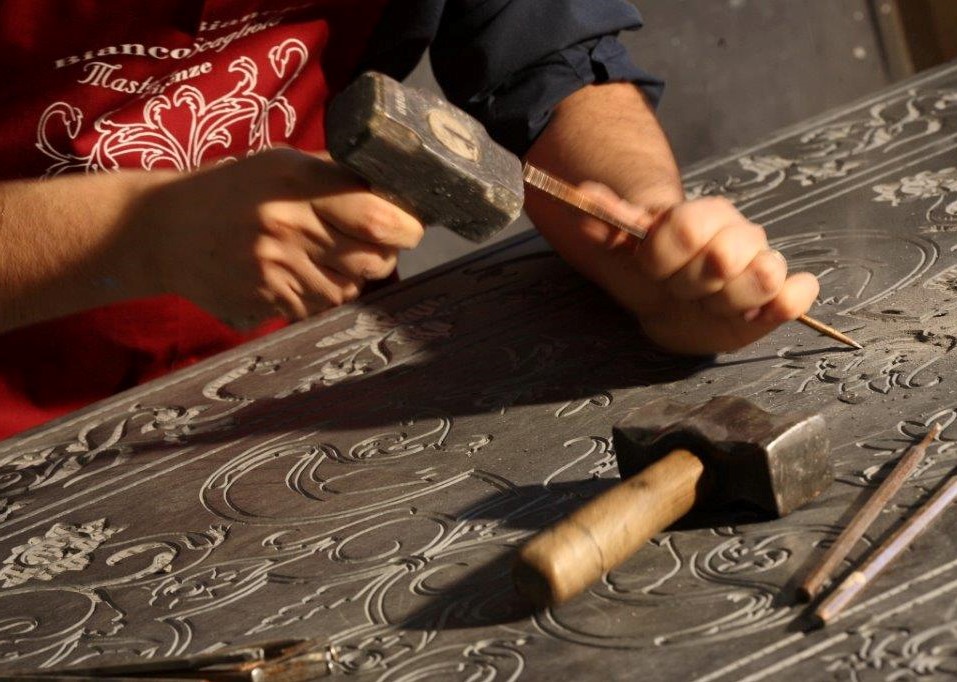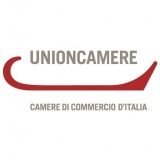
The technique of stucco, which is used to replace or recall more precious materials, has its origins in antiquity. However, another technique that derived from stucco: scagliola, understood as a mixture of selenite, water, glue and natural pigments, developed its own autonomy of expression from the 17th century, and became widespread in Europe throughout the the 19th century. As far as Italy is concerned, the oldest scagliola artefacts are to be found in Emilia Romagna, which is not well doted with marbles or precious stones, but is rich in selenite, a mineral that is particularly prominent in the Modena and Reggiano Appennines.
Florentine Scagliola
The production of Florentine scagliola dates back to the first half of the seventeenth century, where marbled stucco artefacts were used as a cheaper alternative to pietra dura inlay.
During the eighteenth century however, Florentine scagliola freed itself from this commitment and opened its expressive horizons to new possibilities, becoming a pictorial genre of its own. By abandoning the imitation of stone inlay, it helped achieve the shades and chiaroscura contrasts that are inherent in painting.
During the early nineteenth century a flourishing era of scagliola was heralded by productions by highly specialised artisans that worked with great refinement, using landscapes and historical themes that were so dear to the Romantic sensibility as their figurative subjects. Many of the artists working in Florence with scagliola were originally from Livorno, including the Della Valle brothers. Still in the nineteenth century, they received a chair at the Academy of Florence.
Their productions were not simply limited to liturgical objects but quickly became a fashionable symbol of social standing. They were used to adorn palaces and aristocratic villas, as well as being put to use in cabinet-making, so much so that in the early nineteenth century there was a renewed fervour for scagliola production.
During the 1950s, a group of artists working in Florence gave life to a brief revival of scagliola. With a spirit that was controversially anti-academy and anti-bourgeois, they propounded a revival of the old technique, namely materials connected to tradition and to artisan culture.
Despite their conceptual plans to recover the old technique, their sporadic attempts were above all experimental in nature as, in addition to the traditional artisan materials, they often adopted the use of new artificial products such as recently invented resins and polyesters. While these artifical products facilitated a working process that was similar to scagliola, in reality it was quite different.
Two of these artisan-artists include Mauro Bini and Renato Bittoni along with their contemporary Bianco Bianchi (1920-2006), who produced his own experiments and attempted to recover the technique by using the original materials. He was an artisan collector whose “work was characterised by philological rigour and loyalty to pure and traditional artisan methods” and who “contributed to the revival of a technique that had previously been lost and forgotten about”.
Scagliola works may be observed today in Florence at the church of San Miniato al Monte, in the Oratory of St. Thomas Aquinas, at the Uffizi, Palazzo Pitti, the Workshop of Semi-Precious Stones and in the surroundings of Florence such as Settignano, Chianti, Valdarno, Valdisieve, not forgetting the Abbey of Vallombrosa that preserves many works by Enrico Hugford. Scagliola works can be admired in some prestigious museums abroad including the Victoria and Albert Museum in London, the Louvre in Paris and private collections in the USA.
Production techniques
The art of scagliola originates from stucco techniques which, since antiquity, have often been used to substitute and recall more precious materials. With scagliola in particular you can obtain a type of stucco that allows you to perfectly replicate marble and pietra dura.
The reasons why it is used are quite self-evident: it was readily available, could be easily worked (thus reducing production times), was relatively cheap, and allowed you to restore and to enhance an existing artefact.
In the seventeenth century, scagliola perfectly imitated not only marble but also other precious materials such as ivory, porcelain, metals and pietra dura. It complied perfectly with the needs of the poetic baroque, namely decorative exuberance, leisure and the quest for a “surprise” effect obtained by a paradoxical illusion: the resplendent and compact imitation marble surfaces aroused wonder even in the most rational of visitors, but only by actually touching the object could the visitor be sure of this deception.
Thus art required artifice and a pretence in order to provide an alternative reality that, however illusory, was no less spectacular and exciting. The ecclesiastical orders involved in the counter-reformation movement also contributed to the development of this technique by using art as a propaganda tool. A decorative aspect and Baroque illusion was used to attract followers and to regale them emotionally: the delusion between the real and the plausible, between fiction and reality, helped to transport the viewer's imagination from the physical space to the celestial space. It is no coincidence that the end of scagliola and other imitative techniques occurred only at the start of the twentieth century with the advent of a rational architecture that, by eliminating every sort of decorative element, led to disdain for everything that was not original or strictly functional for a building's use.
In light of these considerations, it would be reductive to interpet the use of scagliola simply as a cheap and alternative solution to more precious and expensive materials, and to ascribe the success of this art form to reasons of pure practicality. Nor could that explain the popularity of this technique with European princes and sovereigns.
Despite the use of materials that were considered poor, over time Scagliola has taken on connotations of its own, founding stylistic features and techniques originating from different artistic expressions, such as engraving, woodcuts, commesso, and painting, and has played an important role in the history of art, achieving full artistic and expressive autonomy.
The production stages
Preparation of the plaster
The key ingredients that make up the plaster, namely: gypsum (selenite), animal glue and natural pigments, have never changed and only by using these can you initiate the proper scagliola method.
The base material used for scagliola artefacts is a variety of gypsum (known in chemistry as calcium sulphate dihydrate) that stands out for its laminated crystal structure that has the appearance of transparent scales. The main characteristics of this type of gypsum are a compact and fine grain, transparency and shininess.
For these benefits, the Greeks used it instead of glass and called it selenite. In order to be used in the plaster, selenite must first be heated to 128° so that it loses three quarters of the crystallisation water and is turned into calcium sulphate dihydrate.
When the plaster dries out it becomes very hard and compact, though it remains a fragile material if subject to bad weather.There were many different glues that were formerly used to delay hardening of the scagliola and give greater malleability to the mixture, but the most common was that which was called “German glue” (“strong glue”, or “mother glue”)
It had to be submerged in water for at least 24 hours and be subject to boiling on a low heat for at least three hours. When it was suitably mixed with the water, a “water glue” was created, a very diluted form of glue. The pigments used for colouring the mixture had to be compatible with the gypsum and had to belight-resistant.
Traditionally, the pigments used for colouring the mixture may be classified as minerals (natural or artificial); natural organics (animal and vegetables); and artificial organics.
The main colours for scagliola, especially in its original form, were white and black. White would be obtained from the alabaster gypsum or titanium. Meanwhile, black would be obtained from the calcination of ivory, the carbonisation of vines or the combustion of organic substances.
Mineral pigments would always be used for the other colours (mercury sulphide for red, iron oxides for yellow ochre, cobalt aluminate for blue, and basic copper carbonate for green). Having been heated in the furnace, the now pulverised gypsum is further crushed in a mortar and carefully sifted to avoid lumps and to ultimately obtain a very fine white powder . The scagliola gypsum is produced industrially and is available ready-made.
After a brief ageing period in dry environments, water is then once again added to the powder, making sure that the right amount is added to avoid making the product too fragile and porous.
The glue should also be dissolved in the water, as it serves to slow down the solidification process of the gypsum. Then the pigments are added (either dry or with the addition or very small quantities of water and glue).
Finally, hardeners or waterproofing agents may be added along with other additives (albumin or potassium alum). The consistency of the mixture depends on what it will be used for. For marbled stucco, a mixture should be achieved that is similar to dough used for making bread, while for small details or single colour touches, the scagliola gypsum may be stuck when in a more liquid state. The cover design will then be made by using the powder.
Once the composition has been set, the design will be carefully reproduced with all the details on paper or on gloss (formerly, the cartoon was prepared and the powder technique was used) and then, by resting it perfectly on the cover of the scagliola, the imprint will be made.
Once it has been brought back it will be engraved with the use of pointed irons used to make the incision. For small details or single colour touches, the scagliola can be stuck on in a more liquid state. In other cases, it is preferable to make it more solid or more doughy. The shades and chiaroscuro may be obtained through touches with brush tips that were in use in the nineteenth century.
The colours are added and polished one at a time until the desired polychromy is achieved and it is during this production phase that small details and finishes can be better defined. Scagliola technique artefacts are not particularly difficult to preserve, and the most common damages can be attributed to a high level of humidity, impacts, scratches and marks than can graze the plaster. However, these damages can be remedied by regular maintenance and the use of a simple coat of beeswax to protect the surface.
Production technique of marbled stucco
Until the nineteenth century, the scagliola technique was widely used as an architectural element and as imitation marble sculptures.
The effect could be obtained by mixing lumps of previously coloured scagliola, in order to achieve the desire result. It was the same technique that was used to cover entire walls or architectural elements (columns, pilasters, pedestals, and balustrades).
The marbling would usually come in three variants: stained marble (obtained by placing one marbling aside the other at irregular distances with different colour plasters); veined marbling (the different coloured plasters overlap one another and are then smoothed together); granite marbling (an effect obtained by inserting pieces of coloured plaster in the single colour mixture, dried, crumbled and sifted aside).
Scagliola painting
Even today the process of obtaining pictorial effects in scagliola is not entirely clear. The secret has been lost but by analysing the works we can make some assumptions. The base technique of the paintings was that of inlayed scagliola (the composition made on the cover was carved and different coloured mixtures were stuck on the inlays) and the technique involved obtaining half-tones with variously shaded mixtures.
Generally however, the compositions were refined with a brush in order to obtain pictorial effects that would otherwise be impossible with a single inlay.
By Camera di Commercio di Firenze with Unioncamere



